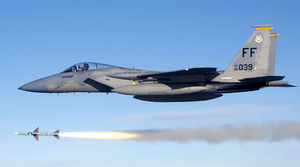F-15 Eagle: Difference between revisions
imported>Howard C. Berkowitz (type and generation) |
imported>Howard C. Berkowitz (added graphic) |
||
| Line 1: | Line 1: | ||
{{subpages}} | {{subpages}} | ||
The '''F-15 Eagle''' aircraft is a series of [[fighter aircraft#Air superiority fighter|air superiority fighter]]s, designed for the [[United States Air Force]]. Production began with the F-15A single-seat and F-15B two-seat (trainer) versions; the current U.S. production versions are the F-15C and F-15D. In the system of fighter generations, it is usually considered [[fighter aircraft#fourth generation|fourth generation]]. | The '''F-15 Eagle''' aircraft is a series of [[fighter aircraft#Air superiority fighter|air superiority fighter]]s, designed for the [[United States Air Force]]. Production began with the F-15A single-seat and F-15B two-seat (trainer) versions; the current U.S. production versions are the F-15C and F-15D. In the system of fighter generations, it is usually considered [[fighter aircraft#fourth generation|fourth generation]]. | ||
[[Image:USAF F-15C fires AIM-7 Sparrow 2.jpg | thumb | F-15 firing AIM-7 Sparrow air-to-air missile , now replaced by the AIM-120 AMRAAM ]] | |||
While an informal motto for the designers was "not a pound for air to ground", a two-seat [[fighter aircraft#fighter-bomber|fighter-bomber]] variant, the [[F-15E Strike Eagle]], has proved to be a formidable combat performer. | While an informal motto for the designers was "not a pound for air to ground", a two-seat [[fighter aircraft#fighter-bomber|fighter-bomber]] variant, the [[F-15E Strike Eagle]], has proved to be a formidable combat performer. | ||
Revision as of 08:50, 8 June 2008
The F-15 Eagle aircraft is a series of air superiority fighters, designed for the United States Air Force. Production began with the F-15A single-seat and F-15B two-seat (trainer) versions; the current U.S. production versions are the F-15C and F-15D. In the system of fighter generations, it is usually considered fourth generation.
While an informal motto for the designers was "not a pound for air to ground", a two-seat fighter-bomber variant, the F-15E Strike Eagle, has proved to be a formidable combat performer.
Role
Before the F-15E was developed, the F-15 series was seen as a "high end" air superiority fighter. Under John Boyd's concept of "high-low", the F-16 Fighting Falcon was the Air Force low end, intended as a fighter-bomber although having significant air superiority capability.
Foreign operators
There are a number of foreign operators, including Israel, Japan, and Saudi Arabia, with variants specific to national needs and U.S. export controls.
Successor
For the United States, the successor to the F-15 air superiority and probably advanced fighter bomber series is the F-22 Raptor.
F-15s can extend their range both with aerodynamically efficient conformal fuel tanks that effectively become part of the fuselage, as well as wing-mounted drop tanks. Still, they routinely use air refueling.
